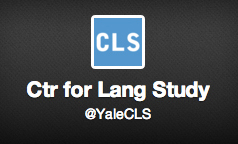 With all the year-end reflections, New Year’s prognostications, and two-week check-ins on how you’re doing with your resolutions anyway, it seemed like a perfect time and place to think out loud about where the CLS has come on its primary social media outlet, Twitter, and where it might be headed. For me, it’s not just a casual interest, since I’ve fairly recently inherited tweeting responsibilities from colleagues who have built the CLS’s presence there since 2007. It’s a fascinating venue for gleaning information about language-related events both near and far, learning about professional development opportunities, catching up on hot news topics, and building professional networks. I’d be happy for @YaleCLS to continue to grow as a resource for those interested in language teaching and learning, as I knew it to be before I came to Yale. And now that I’m here, the little bird chirping on my shoulder makes me wonder…are we doing the best that we can do? Am I?
With all the year-end reflections, New Year’s prognostications, and two-week check-ins on how you’re doing with your resolutions anyway, it seemed like a perfect time and place to think out loud about where the CLS has come on its primary social media outlet, Twitter, and where it might be headed. For me, it’s not just a casual interest, since I’ve fairly recently inherited tweeting responsibilities from colleagues who have built the CLS’s presence there since 2007. It’s a fascinating venue for gleaning information about language-related events both near and far, learning about professional development opportunities, catching up on hot news topics, and building professional networks. I’d be happy for @YaleCLS to continue to grow as a resource for those interested in language teaching and learning, as I knew it to be before I came to Yale. And now that I’m here, the little bird chirping on my shoulder makes me wonder…are we doing the best that we can do? Am I?
So, where has the CLS on Twitter come in the last year? To answer this, I started by looking at some of the many analytics tools out there–tools that can help you get a better sense of what particular Twitter users and networks of people are doing over time. Eventually, I took media theorist Lev Manovich‘s recommendation to his Spring 2013 Big Data, Visualization, and Digital Humanities class at CUNY and checked out Twtrland and Twitonomy, in addition to Twitter’s own analytic tool. Having these tools scan through the CLS’s behavior reveals, for instance, that of the approximately 1300 users that now follow the CLS, approximately 76% are from the U.S., while 23% are located in New Haven. One can also see interesting facts about the content of what we post: over 70% of our tweets have links in them, while just 14% are straight text, and so on.
There’s of course much more fine-grained analysis that can be done automatically through sites like these, often with colorful charts and maps as their output. But to get a real sense of what kinds of things the CLS has tended to tweet about–and to think in detail about where we go in 2014–I basically reverted to the old-school techniques of reading and note-taking, post by post, from the January 3 2013 tweet reminding readers of the January 9 deadline for submitting proposals for the recent ACTFL convention, to our “Happy New Year” tweet of December 31st (jumping the gun, perhaps?).
Here’s what I found:
- A great number of tweets covered goings-on at the CLS itself. These included events such as the May Instructional Innovation Workshop by Mary Toulouse on e-portfolios, the fall Foreign Language Pedagogy Workshop for graduate students, the Open House with its teaching demonstrations by Sandra Sanneh and Bonny Wassing, guest lectures by scholars such as Glenn Levine and Nina Spada, and Brown Bag workshops (for instance Sarab Al Ani’s in the fall on OWL for language practice and assessment). We also tweeted some ‘signposts’ for ongoing programs: new courses, conference presentations, and news coverage of the the Yale-Columbia-Cornell Shared Course Initiative, orientations for the ELP (English Language Program) and DILS (Directed Independent Language Study) programs, drop-in tutoring for Spanish, Chinese, and French, and more. One other area we experimented with was pointing to the other CLS places on the web where things were happening: conference reports by Marion Gehlker, Ling Mu and others posted to the blog at the beginning of the year, starts and additions to the Diigo social bookmarking group, and even new posts here on Multilingual Commons.
- Events and happenings at Yale were a key focus as well. From the Yale Teaching Center’s Online Teaching Forum in April, to the Jackson Center’s September career panel, to the Yale Hackathon in November, to the Spring Digital Humanities Symposium, to the launch of the Spanish literary magazine La Madrugada and coverage of the undergraduate multilingual magazine Accent, to open forums on online education and regional foreign film festivals, Yale calendars are full of events of potential interest to language learners and teachers. We tried to cover as many of these as we could, while highlighting our shared interests with other units on campus such as @YaleMacmillan, @YaleCLC, and many others.
- Beginnings of bridges between campus and community. Tweets covering languages and language teaching and learning-related events in New Haven and the surrounding region were much less frequent than those focused on happenings in Yale and at the CLS, but strides were made in this direction. The Connecticut Council of Language Teachers’ Annual Fall Conference in October, Yale High School’s Cooperative Language Program, language & culture events for children at the New Haven Public Library (an effort spearheaded on our campus by Theresa Schenker of German), and the year-end visit by CLS staff to Integrated Refugee & Immigrant Services here in New Haven were among the topics covered.
- The CLS likes professional development opportunities and resources. While the three categories of tweets described above have great appeal to those of us located here at Yale or near by, a great number of Twitter users with whom the CLS interacts are professional organizations located across the country, and in other countries. Professional conferences with broad appeal were of great interest; these included major annual events organized by the Modern Language Association, the American Association for Applied Linguistics and the American Council on the Teaching of Foreign Languages, and regional, smaller, or more focused events such as UCLA’s Heritage Language Workshop, the Ethnography in Education Research Forum, Brown’s Workshop on Language & Culture, the Massachusetts Foreign Language Association’s fall conference, and the Center for Advanced Study of Language’s “Languages for All?: The Anglophone Challenge” forum (among many, many others). Other professional development resources tweeted included journal calls (e.g., IALLT Journal for Language Learning Technology, L2 Journal, Digital Humanities Quarterly, Critical Multilingualism Studies) and training events such as Penn’s summer language courses, CARLA’s summer institutes, and NFLRC’s Language for Specific Purposes Summer Institute.
- News, news, news. Probably more than anything else in the twittosphere (or at least the part of it concerned with language learning and teaching), items about language in the news circulate among individuals and large-scale organizations (companies, universities, media outlets) alike. And the CLS was no exception. Our tweets highlighted topics related to multilingualism and monolingualism in the U.S. (an article on English-only for Spanish-speaking students in the U.S., a popular Census Bureau interactive map showing 15 languages spoken in the U.S., a piece on the politics of defining the “English language learner” in schools, etc.), topics in language extinction and preservation (an article on saving Aramaic from extinction, another on Welsh dying, and a film entitled “Language Healers” on Native American language revitalization efforts), and the ascendance and problems encountered by Massive Open Online Courses (articles on the nature of economic deals being made between MOOC providers and universities, MOOC efforts at internationalization, and the post-SJSU/Udacity re-evaluation of MOOCs). Much other news defies such easy categorization here: the crisis faced by National Language Resource Centers, the ACTFL release of a position statement on languages as a core component of education, the influence of study abroad on personality, children’s stories in ASL, and on and on. With aggregator tools such as Google Alerts and language news sites like Langology circulating dozens if not hundreds of language news articles daily–not to mention those from the many mailing lists we might be subscribed to–passing on a variety of salient news, without overwhelming one’s readers (or oneself!) is a mighty task indeed.
Well, our ‘virtual closet’ is starting to look pretty emptied out. And seeing all this stuff again out in the air gives rise to some ideas about where we might need to go in 2014, this year we’re already two weeks (and 34 tweets, as of this post) into. Key questions on my mind include:
- Do our tweets do justice to the intersection of interests and character of the CLS, on one hand, and those of our audiences, on the other?
- How do we gain a better sense of who our (other) audience(s) are?
- How can we tweet in a way that makes for meaningful content and dialogues with more than one audience? Specifically, how can we speak locally, regionally, and to more distantly located audiences? (and how desirable is increased dialogue with Twitter users outside the U.S.?)
- As a language center tweeting and re-tweeting the news, how should we better select which items to pass on? Should we be doing more? And how much interpretation/editorializing should we do, as opposed to tweeting “just the facts”?
- Should we tweet more language-specific content?
- Should we tweet more (language teaching, linguistics, other) job announcements?
- How can the CLS on Twitter help scaffold language instructors’ use of Twitter and other social media platforms for: 1.) identifying target-language and target-culture news, media, and other resources; 2.) professional networking and development; 3.) teaching and supporting students’ learning of languages (“How can I use Twitter in my language class?”)
As time goes on, I’ll try to add a few more questions to this list. But before I write any more, I’d like to put these questions to you, dear reader: Where do you think the CLS should go from here?
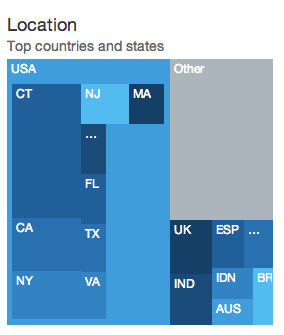
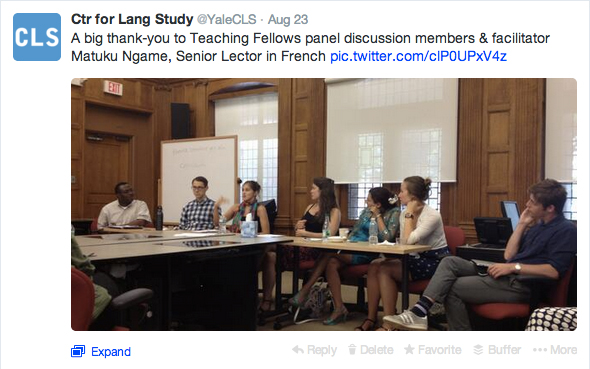
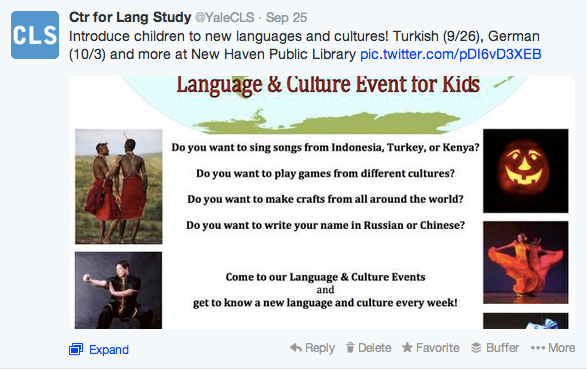
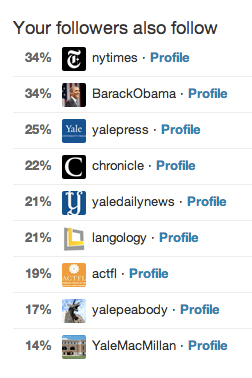
0 comments for “CLS on Twitter, 2013 Edition”